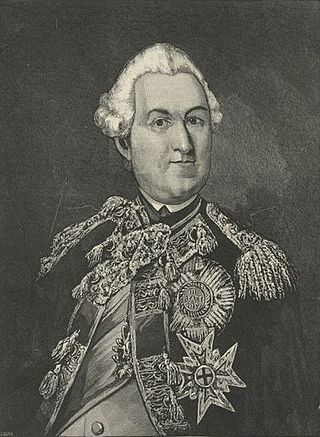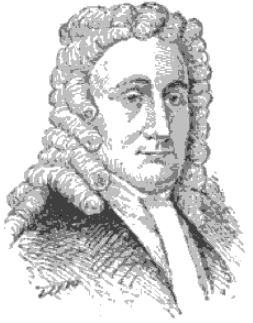
Edward Hyde, 3rd Earl of Clarendon, styled Viscount Cornbury between 1674 and 1709, was an English aristocrat and politician. Better known by his noble title Lord Cornbury, he was propelled into the forefront of English politics when he and part of his army defected from the Catholic King James II to support the newly arrived Protestant contender, William III of Orange. These actions were part of the beginning of the Glorious Revolution of 1688. Cornbury's choice to support his cousin Anne instead of William after the rebellion cost him his military commission. However, Cornbury's support of King William's reign eventually earned him the governorship of the provinces of New York and New Jersey; he served between 1701 and 1708.

Andrew Hamilton was the colonial governor of East and West New Jersey from 1692 to 1697 and again from 1699 to 1703. He also served as Deputy Governor of the neighboring Province of Pennsylvania.

The Province of New Jersey was one of the Middle Colonies of Colonial America and became the U.S. state of New Jersey in 1776. The province had originally been settled by Europeans as part of New Netherland but came under English rule after the surrender of Fort Amsterdam in 1664, becoming a proprietary colony. The English renamed the province after the island of Jersey in the English Channel. The Dutch Republic reasserted control for a brief period in 1673–1674. After that it consisted of two political divisions, East Jersey and West Jersey, until they were united as a royal colony in 1702. The original boundaries of the province were slightly larger than the current state, extending into a part of the present state of New York, until the border was finalized in 1773.

Jacob Leisler was a German-born colonist who served as a politician in the Province of New York. He gained wealth in New Amsterdam in the fur trade and tobacco business. In what became known as Leisler's Rebellion following the English Revolution of 1688, he took control of the city, and ultimately the entire province, from appointees of deposed King James II, in the name of the Protestant accession of William III and Mary II.

Leisler's Rebellion was an uprising in late-17th century colonial New York in which German American merchant and militia captain Jacob Leisler seized control of the southern portion of the colony and ruled it from 1689 to 1691. The uprising took place in the aftermath of England's Glorious Revolution and the 1689 Boston revolt in the Dominion of New England, which had included New York. The rebellion reflected colonial resentment against the policies of deposed King James II.

Pieter Schuyler was the first mayor of Albany, New York. A long-serving member of the executive council of the Province of New York, he acted as governor of the Province of New York on three occasions – twice for brief periods in 1709, after the death of Lord Lovelace, and also from 1719 to 1720, after Robert Hunter left office.
Henry Hyde, 4th Earl of Clarendon and 2nd Earl of Rochester, PC, styled Lord Hyde from 1682 to 1711, was an English Army officer and Tory politician who sat in the English and British House of Commons from 1692 until 1711 when he succeeded to the peerage as Earl of Rochester.

Lewis Morris, chief justice of New York and British governor of New Jersey, was the first lord of the manor of Morrisania in New York City.

Lieutenant-General Francis Nicholson was a British Army general and colonial official who served as the governor of South Carolina from 1721 to 1725. He previously was the Governor of Nova Scotia from 1712 to 1715, the Governor of Virginia from 1698 to 1705, the Governor of Maryland from 1694 to 1698, the Lieutenant Governor of Virginia from 1690 to 1692, and the Lieutenant Governor of the Dominion of New England from 1688 to 1689.
Henry Sloughter was briefly colonial governor of New York in 1691. Sloughter was the governor who put down Leisler's Rebellion, which had installed Jacob Leisler as de facto governor in 1689. He died suddenly in July 1691. Lieutenant Governor Richard Ingoldesby, who had served against Leisler's rebels, took over after Sloughter's death until the arrival of Benjamin Fletcher.

Richard Coote, 1st Earl of Bellomont, known as The Lord Coote between 1683–89, was an Irish nobleman and colonial administrator who represented Droitwich in the English Parliament from 1688 to 1695. He was a prominent Williamite, supporting William III and Mary II during the Glorious Revolution.

The lieutenant governor of New Jersey is an elected constitutional officer in the executive branch of the state government of New Jersey in the United States. The lieutenant governor is the second highest-ranking official in the state government and is elected concurrently on a ticket with the governor for a four-year term. The position itself does not carry any powers or duties other than to be next in the order of succession, but the state constitution requires that the lieutenant governor also be appointed to serve as the head of a cabinet-level department or administrative agency within the governor's administration, other than the position of Attorney General.

John Lovelace, 4th Baron Lovelace (1672—1709) was the Governor of both New York and New Jersey.

Gerardus Willemse Beekman was a wealthy physician, land owner, and colonial governor of the Province of New York.

The New York – New Jersey Line War was a series of skirmishes and raids that took place for over half a century between 1701 and 1765 at the disputed border between two American colonies, the Province of New York and the Province of New Jersey.
John Evans was a colonial governor of Pennsylvania, 3 February 1704 through 1 February 1709.
Captain Andrew Bowne was an American colonial politician and jurist, who served in various capacities in both New York and New Jersey.
William Pinhorne was an American colonial politician and jurist, who served in various capacities in both New York and New Jersey.
John Barclay was a Scottish Quaker, younger brother of Robert Barclay and a member of Clan Barclay. He held several government positions the East Jersey colony in North America and was a member of the New Jersey General Assembly from 1704 to 1706.














